Key takeaways:
- Editing is essential for enhancing storytelling in photography, bridging the gap between the captured moment and the intended emotion.
- Utilizing tools like Adobe Lightroom and Photoshop can significantly transform images and allow for in-depth creative expression.
- A structured editing workflow, involving image selection, basic adjustments, and local enhancements, is crucial for focused edits.
- Seeking feedback, experimenting with styles, and taking breaks can greatly improve the editing process and reveal new perspectives.
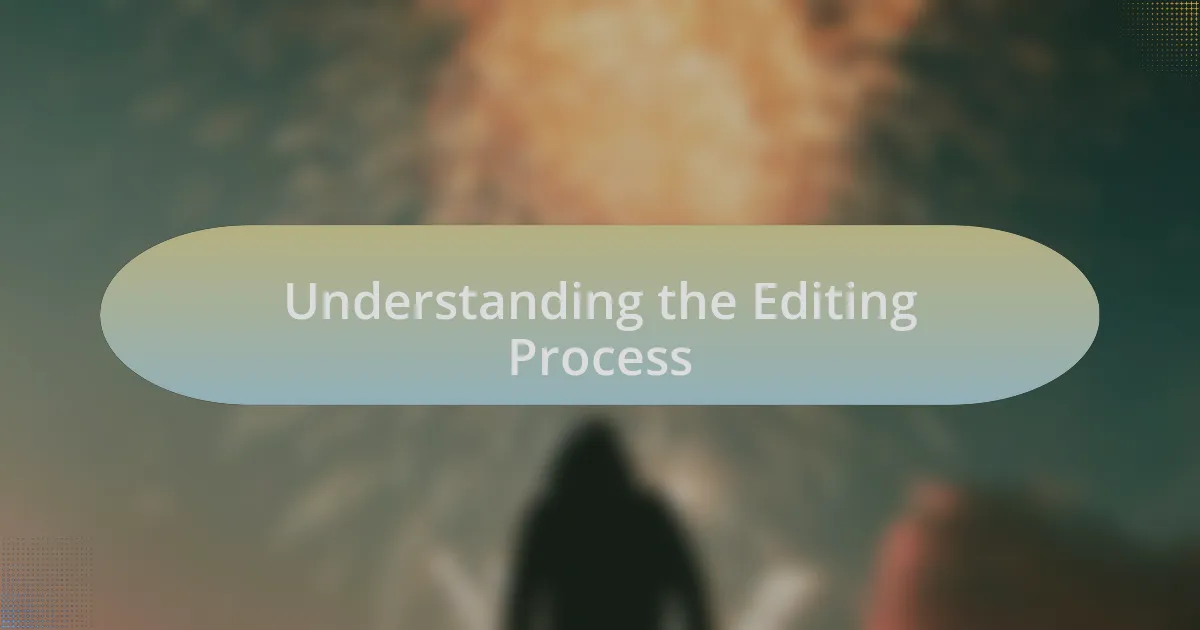
Understanding the Editing Process
Understanding the editing process begins with recognizing that it’s not just about correcting mistakes; it’s about enhancing the story a photograph tells. I often find myself staring at an image, contemplating how a subtle tweak in contrast or brightness could completely change its mood. Have you ever felt that rush when you realize a small adjustment can transform a dull picture into something vibrant and engaging?
For me, editing is almost meditative. As I sift through the images, I become reacquainted with the emotions tied to those moments captured. Each adjustment becomes a step deeper into the narrative—whether it’s brightening shadowy details to evoke hope or cooling colors to instill solitude. Does this not resonate with you too? The emotional connection drives our choices, shaping how we want to convey our vision.
Sometimes, I hit creative blocks during editing, just like I do in shooting. I’ve learned to step away, let my mind rest, and return with fresh eyes. It’s fascinating how a little distance can illuminate new possibilities. Perhaps you’ve experienced this as well—realizing that sometimes the best part of the editing process is simply allowing yourself the time to discover what truly resonates.
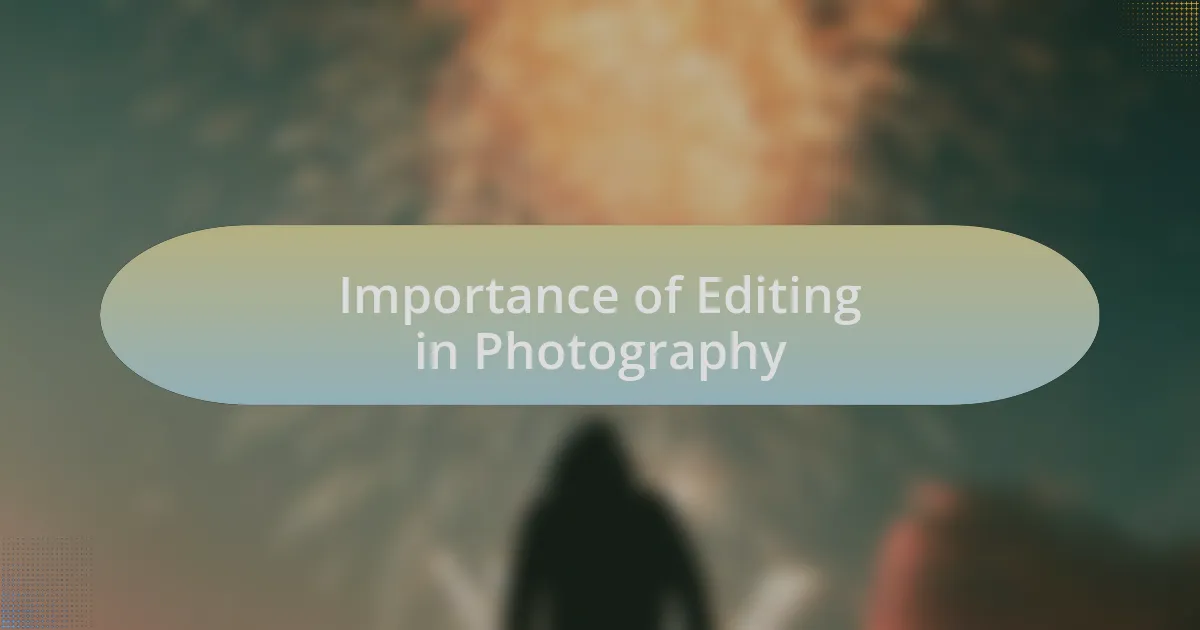
Importance of Editing in Photography
Editing is crucial in photography because it allows the photographer to refine their vision. I remember a time when I thought I had the perfect shot, only to realize that a slight adjustment in saturation brought out the colors in a way I hadn’t anticipated. Have you ever looked at an image and felt something was missing, despite it being technically sound? That’s where editing shines, bridging the gap between the captured moment and the emotion we want to convey.
Moreover, editing adds a layer of artistry that elevates a photograph from mere documentation to personal expression. One of my favorite edits involved transforming an ordinary landscape into an ethereal scene by enhancing the golden hour hues. It truly felt like I was painting with light. Doesn’t it thrill you to think about how a few tweaks can completely reshape the narrative of a photo?
Ultimately, editing serves as a tool for storytelling in photography. It’s like revisiting a journal entry and emphasizing the parts that matter most. I often ask myself, “What reaction do I want this image to evoke?” That question guides my edits. Have you integrated that kind of intentionality into your editing process? The journey of refining an image often unveils deeper layers of meaning and invites viewers to engage with the story behind the photograph.
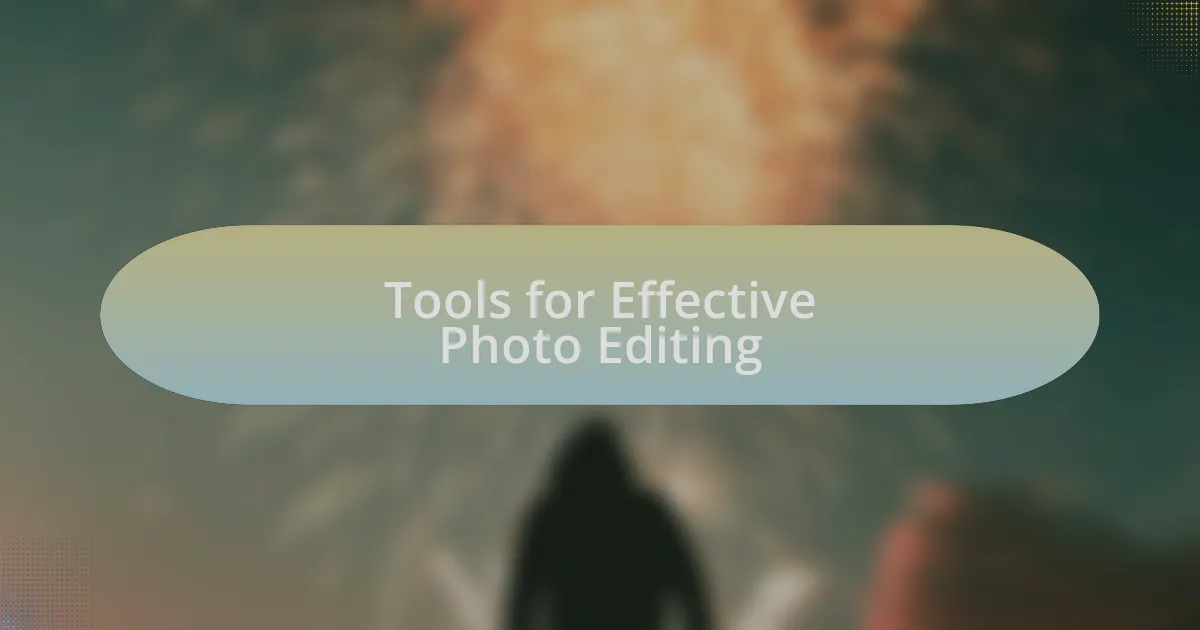
Tools for Effective Photo Editing
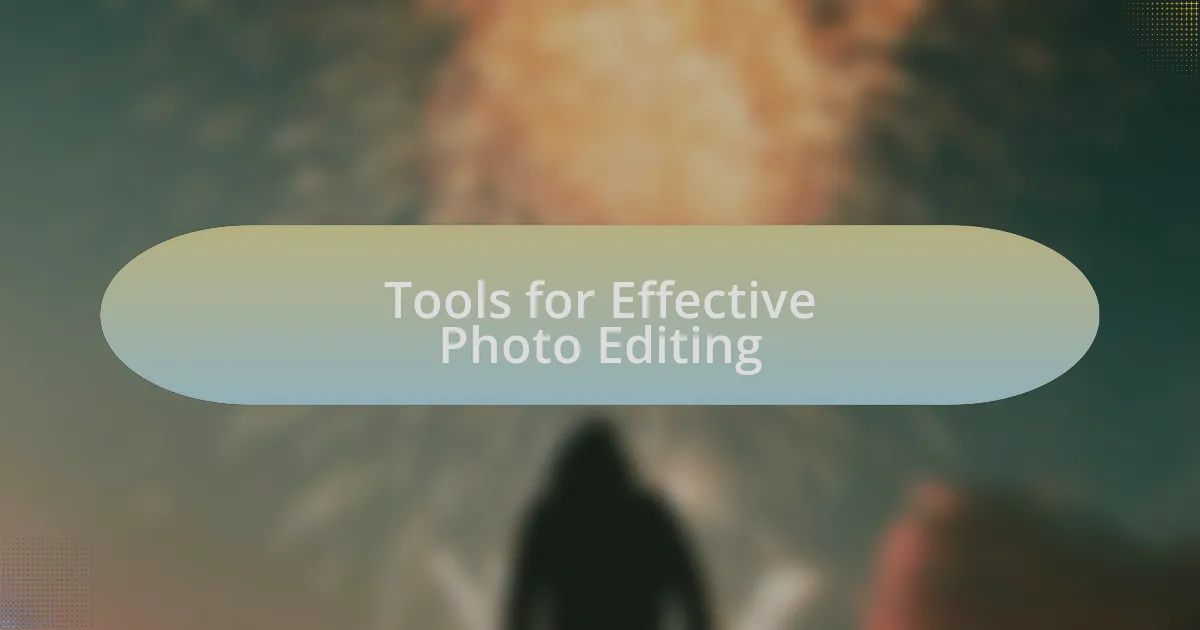
Tools for Effective Photo Editing
When it comes to photo editing, having the right tools can make a transformative difference. I remember my first experience with Adobe Lightroom; it was like stepping into a world of possibilities. The sliders for exposure and contrast felt intuitive, allowing me to breathe new life into an image that initially seemed dull. Have you explored Lightroom yet? Its ability to handle large batches of photos while maintaining quality is something that every photographer should experience.
Another game-changer in my editing arsenal is Photoshop. I was initially overwhelmed by its complexity, but once I grasped the basics, I found it opened doors to creativity I never knew existed. For instance, using layers allowed me to create composite images that told more intricate stories. Have you tried blending images in this way? It can be incredibly rewarding when you see the finished work come together.
Lastly, I can’t overlook the value of mobile editing apps like Snapseed. I often edit on-the-go, and this app has been a lifesaver. Recently, I edited a picture while waiting for a friend, quickly adjusting brightness and adding filters to match the mood I envisioned. Isn’t it amazing how powerful editing tools can fit right in your pocket? Each tool contributes uniquely, shaping how we express our artistic vision.
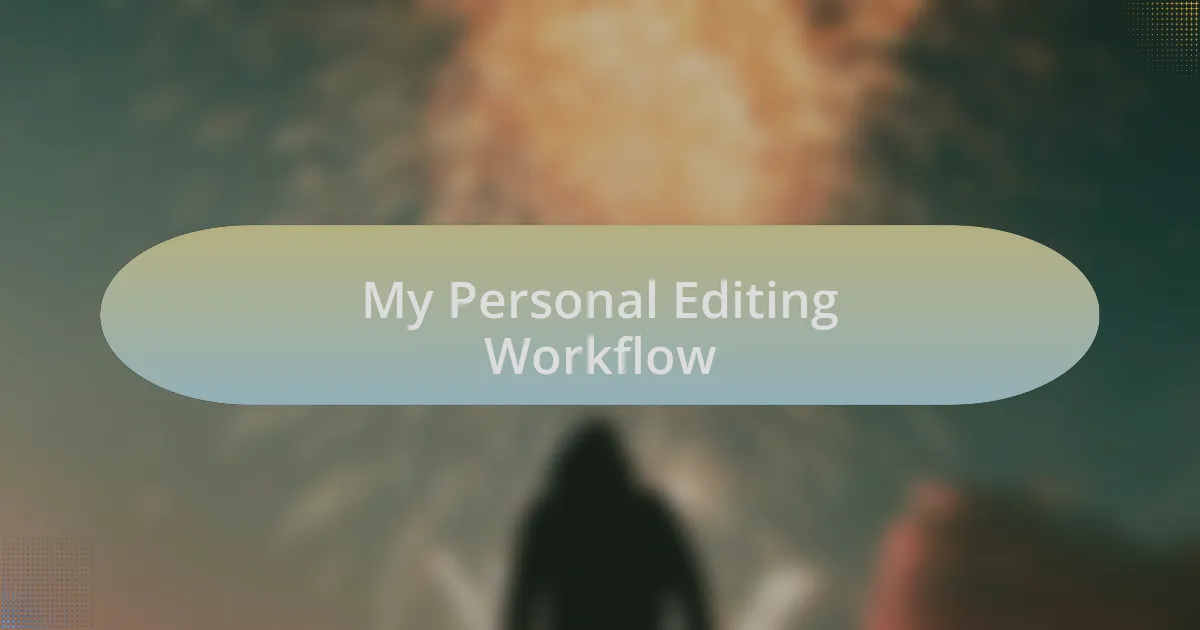
My Personal Editing Workflow
When I sit down to edit, the first step in my workflow is sorting through my images. I often find myself reminiscing as I review each shot, reliving the moment it was captured. Do you ever feel a connection to your photos? It’s crucial to select the ones that resonate most before diving deeper—this makes editing more focused and fulfilling.
After I’ve chosen the images, I usually start with basic adjustments in Lightroom, like exposure and white balance. I remember one late night when I was tweaking a sunset shot, concerned it wouldn’t do the scene justice. Adjusting the warmth and contrast felt like bringing the sunset back to life right on my screen. It’s thrilling to see an image transform before my eyes, don’t you agree?
Once I navigate through the foundational edits, I like to experiment with Photoshop for creative touches. I recently spent an afternoon layering different textures on a portrait, which elevated its depth and emotion. Have you ever thought about how a single layer can change the entire narrative of your photo? This aspect of editing really allows me to express my artistic vision and make each piece uniquely mine.
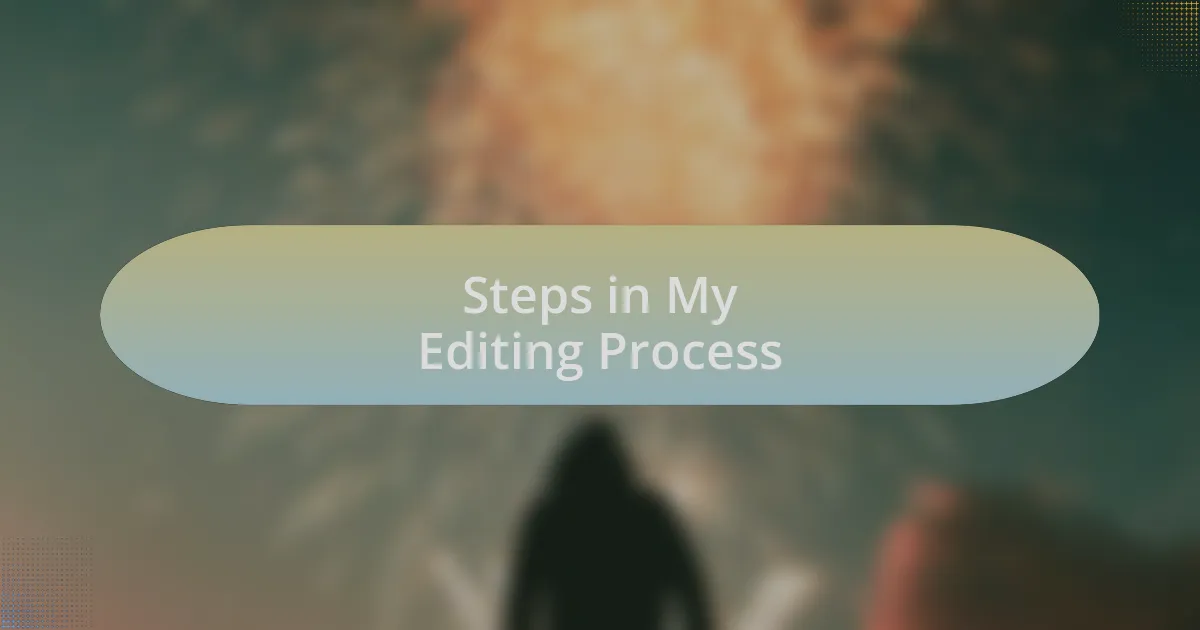
Steps in My Editing Process
When I’m ready to refine an image, my next step is often applying local adjustments. For example, I remember a time when I focused on enhancing the eyes of a subject in a portrait. Bringing out those little details felt like uncovering a hidden story; you wouldn’t believe how much more alive the image looked. Have you tried this technique? It often creates a striking focal point that draws the viewer in.
After local adjustments, I dive into color grading. This can be one of my favorite steps because it transforms the mood of the image entirely. There was a chilly morning when I applied a cool, desaturated palette to a landscape shot, evoking that crisp feeling of the air perfectly. I really enjoy experimenting—what color schemes resonate most with your mood or vision?
Finally, I wrap up my editing process by reviewing the image as a whole. I step back and ask myself if the final piece conveys the emotion I intended. Recently, while finalizing a dramatic black-and-white photo, I realized that sometimes less is more. Have you ever looked at an image and felt it just clicked? That’s the magic moment I strive for in every edit.
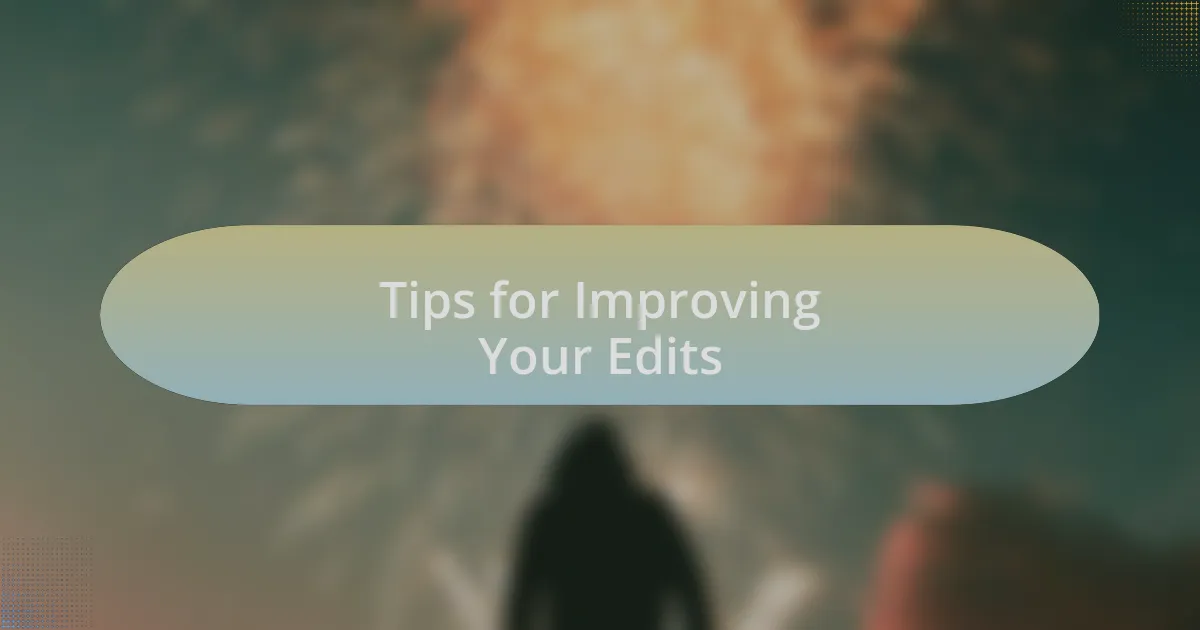
Tips for Improving Your Edits
When it comes to improving your edits, I’ve found that seeking feedback is invaluable. I recall a time when I shared a portfolio with fellow photographers, and one comment about contrast changed my approach entirely. Have you ever experienced an “aha” moment from someone else’s perspective? Inviting constructive criticism can illuminate areas you might have overlooked.
Another tip is to experiment with different styles and techniques. I remember pushing my boundaries by trying out film emulation presets on a digital photo. The unexpected warmth brought an emotional quality that I hadn’t anticipated. Have you explored styles outside your comfort zone? Sometimes, breaking standard conventions leads to surprisingly rewarding results.
Lastly, don’t underestimate the power of taking breaks. I’ve learned that stepping away from my work for a while can provide fresh eyes when I return. Have you noticed how a little distance can change your perception? This simple act often reveals imbalances or distractions I initially missed, making it a crucial part of my editing journey.